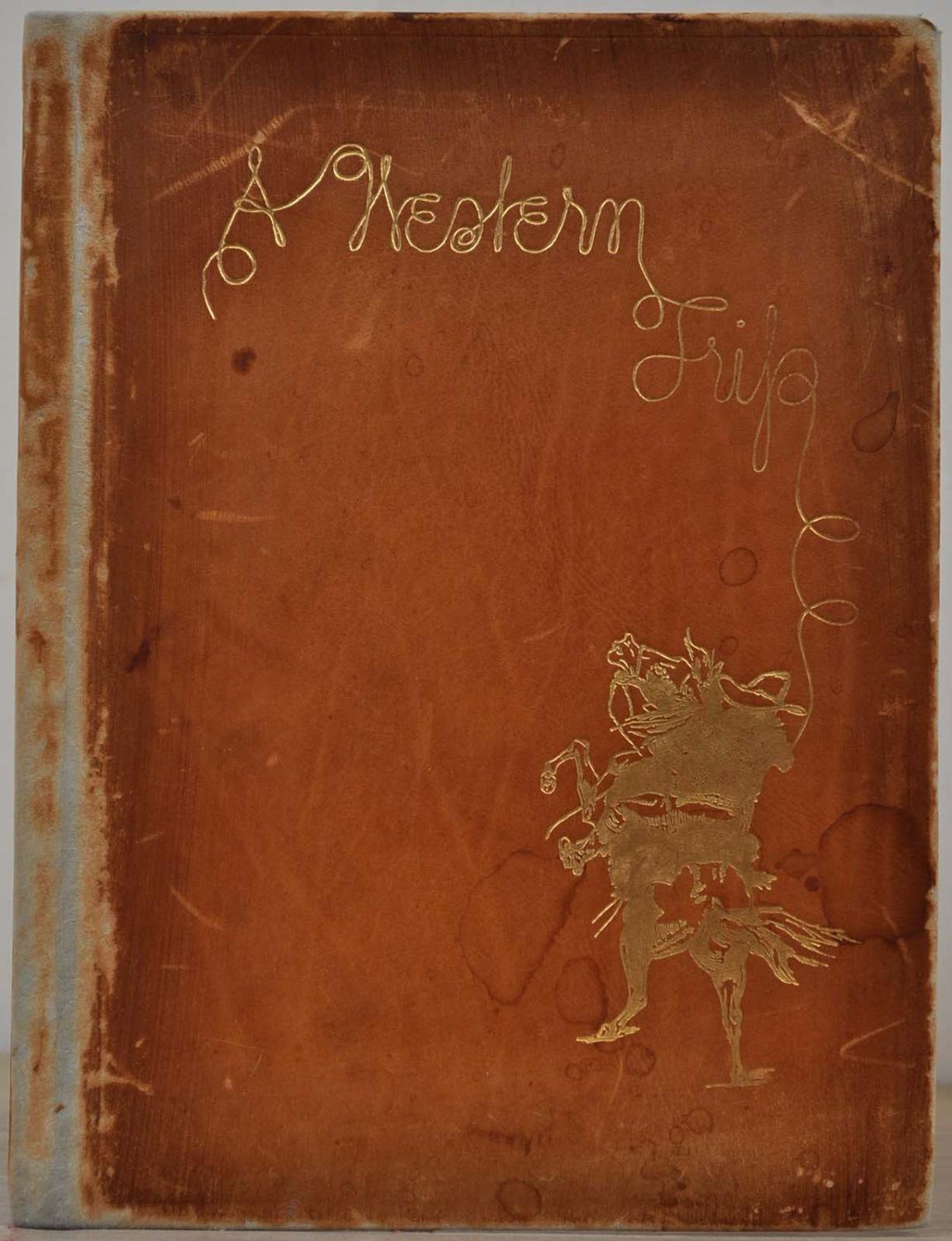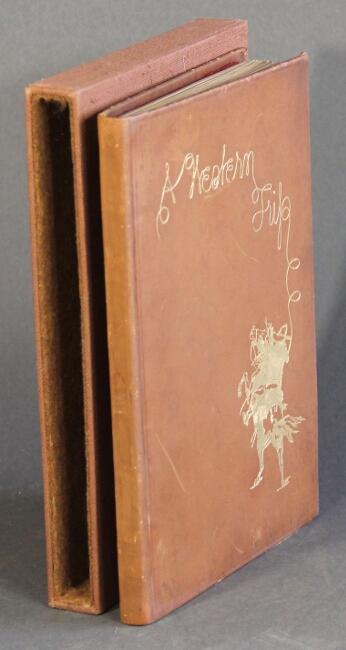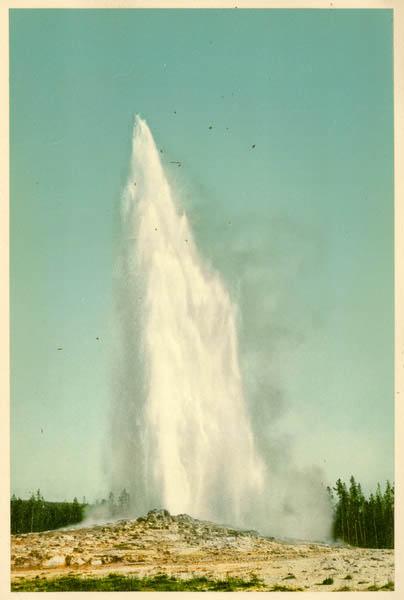Available Copies from Independent Booksellers

Price: US$3500.00 + shipping
Condition: Very Good
Description: 91 pages of text. Original full polished calf binding with gilt decorated front cover; lightly to moderately rubbed on spine and extremities, with several small spots of slight staining to the covers. Beautifully illustrated with twelve tipped-in color photographs by Henry W. Jackson, and numerous in-text black-and-white reproductions. Signed and inscribed by the author on a front endpaper "Adolph George von Carl E. Schmidt Juli 1914." Minor offsetting to pages facing the color photographs. Minor fraying to the red silk endpapers, and minor cracking to the inner hinges. Top edge gilt (t.e.g.) with other edges uncut. The text is clean and unmarked. First edition, "for private circulation only."
Seller: Kurt Gippert Bookseller (ABAA), Chicago, IL, U.S.A.

Schmidt, Carl E.. A Western Trip. [Herold Press] For private circulation only, Detroit, 1904.
Price: US$4500.00 + shipping
Condition: Very Good
Description: First edition. Author's hand-written poem on verso of front free end paper, with his signed inscription on the following page. Bound in publisher's full calf illustrated on the front cover in gilt, with red silk end sheets and deckled edges, with 12 mounted color photographs by Henry Jackson plus 18 halftone images in the text. Very Good, with binding lightly rubbed, spine lightly creased. Fragile silk rear endsheet is partially lifted, and there is a thin strip excised from the front. A scarce and well-preserved volume pertaining to travels in Yellowstone, featuring full page color photographs of famous natural monuments.
Seller: Burnside Rare Books, ABAA, Portland, OR, U.S.A.

Schmidt, Carl E.. A Western Trip. Herold Press] for private circulation only, [Detroit, MI, 1904.
Price: US$4500.00 + shipping
Description: First edition second issue (or edition?), with the smaller illustrations in half-tone rather than as mounted photographs. 8vo. 91 pp., including 12 mounted page-size colored photographic prints [after William Henry Jackson]. 18 smaller illustrations from photographs in the text. Chapter 9 is titled "A Fishing Trip," after trout in Yellowstone Park. Inscribed on the verso of a front endpaper "To my young friend / Rosalind Cook / Carl E. Schmidt / June 1929." Howes S-170. Streeter 4123. Eberstadt 136, 667d: "Printed in a few copies only. An interesting journal of the Yellowstone Country, and because of the circumstances of its printing, extremely difficult to come by." Not in Bruns. OCLC locates thirty copies in three separate entries, without making a distinction between the issues of the smaller illustrations. With the defects to the fragile silk endpapers noted, a very good copy of a scarce work on the Yellowstone, with an inscription by the author. Original gilt-stamped decorated calf (rubbed), silk endpapers (with some restoration work, the front free silk with a tear, the rear pastedown silk badly chipped at the edge before being remounted to the rear board), top edge gilt. (#6817).
Seller: Bartleby's Books, ABAA, Chevy Chase, MD, U.S.A.

Schmidt, Carl E.. A western trip. Herold Press] for private circulation only, n.d., [Detroit, 1904.
Price: US$4687.50 + shipping
Description: 8vo, pp. 91, [1]; 12 mounted color photographs by Henry Jackson (variously copyrighted 1902-1905), plus 18 photographic halftones in the text, title page printed in brown and green, initials printed in green and red; original pictorial tan calf stamped in glt on upper cover, t.e.g., red silk endpapers; some inoffensive old ink stains on the first three leaves of text, else generally fine. This copy with a warm presentation from the author, "To my kindly, thoughtful friend, J. W. Donovan, in the most momentous month & year in the world's history, November 1918, Carl E. Schmidt." Description and travel in Yellowstone Park, the author being accompanied by his daughter, Emma, and Frank and Everett Pingree, the latter a miner from Utah. Schmidt (1858-1934) was educated in the schools of Detroit and Germany, and learned the tanning trade from his father. Schmidt worked in his father's firm, which exported skins, furs, and wool, until the latter's death in 1897; soon after, he opened an independent tannery under the name Carl E. Schmidt & Co. He was active in politics, serving as a member of the Detroit Board of Police Commissioners, the state board of arbitration and mediation, and the state board of forest inquiry. He was for some time a close friend and political advisor to Hazen Pingree, who served as both mayor of Detroit and governor of Michigan. In 1880, Schmidt married Alice M. Candler, the daughter of a prominent Detroit businessman. The couple had three daughters: Emma, Alice, and Ida Wikipedia notes that his home, now the Carl E. and Alice Candler Schmidt House, was built in 1904 at 301 Lake Shore Rd. in Grosse Pointe Farms, Michigan. It was listed on the National Register of Historic Places in 2005. The house is one of the oldest remaining properties in the Grosse Pointes to have a view of Lake Saint Clair. Howes S-170; Streeter VII, 4123; not in Graff.
Seller: Rulon-Miller Books (ABAA / ILAB), St. Paul, MN, U.S.A.

SCHMIDT, Carl E.. A Western Trip. Herold Press, Detroit, 1904.
Price: US$10000.00 + shipping
Description: A WESTERN TRIP TO YELLOWSTONE & MONTANA FEATURING PHOTOCHROMS BY WILLIAM HENRY JACKSON 8vo. 91 [1 blank], [2] pp., 30 mounted photographs (12 full-page photochrome process prints by William Henry Jackson, 18 smaller black and white taken by the party). Original full brown leather gilt-lettered and with gilt illustration of cowboy on rearing horse roping. With author's signed presentation in ink on front flyleaf: "C. L. Levants from Carl E. Schmidt, Jan'y 1905" (ink inscription offset onto the title). An impressive privately produced journal and memoir of a trip to Yellowstone in 1901 written by the wealthy Detroit industrialist Carl Schmidt. This book is an idiosyncratic example of bookmaking, not only because of its unusual illustrative matter, but also because of the author's selection of old English type and the binding created in the author's own tannery. The black and white photographs are candids taken by the party. The color photographs are the work of William Henry Jackson (1843-1942) who served as official photographer of the Hayden survey from 1870-1878 and took the first photos of Yellowstone Park. Leaving Chicago on August 31, 1901, in the company of three other people (his daughter Emma, friend Frank Pingree, and the latter's son Everett), Carl E. Schmidt embarked on a trip inspired by a painting of Yellowstone geysers he saw while waiting in a dining room for his omelet to be served. After describing his train trip West, which included a few humorous detours, Schmidt and his party spent several weeks in Yellowstone enjoying the sites and having various adventures and misadventures, most of which Schmidt describes in a jocular, even-handed manner. Some of the incidents seem to be reflective of the author's own amused awareness of his greenhorn-tourist status. At one point, a trip from the Mammoth Hot Springs Hotel is preceded by Schmidt's elaborate order to the kitchen for lunch, which included an extra two-dollar bill to ensure service. However, when the lunch was opened the next day, it turned out to be nothing but ruined scraps. He also describes a somewhat successful fishing trip in which several trout were caught. However, upon arriving at the hotel and handing over the fish to the cook with instructions for preparation, the fish were ruined because they were fried in "wagon- grease butter." The journal concludes with a visit and descent into a mine near Butte, Montana. Schmidt remarks: "Here comes our party and with them the mine boss, Capt. Sammie. He looks like a highwayman, but we find out later he is a Baptist deacon and plays the organ up at the big camp tent" (p. 85). The trip to the mine also includes a recounting of a shoot-out that occurred a few months before their arrival. On the return trip to Chicago, the party stopped briefly in Salt Lake City. In Exploration and Empire Goetzmann describes the photographer William Henry Jackson's importance, "the greatest of all Western photographers [with the] ability to capture the many scenes of sublime beauty in the West on his photographic plates and stereopticon slides, did more than anyone else to publicize the tourist's West. Jackson, like the avant-garde writers, the scientists, and even the local colorists of his time, was helping to usher in a new era of realism that would in part replace, and at the same time, as far as subject matter was concerned, parallel the romanticism of an earlier day".
Seller: Arader Galleries - AraderNYC, New York, NY, U.S.A.